Mustang Exhaust
For me, one of the most intimidating aspects of building a Mustang is the exhaust trail. Merlin's don't really put out black "soot"...they discolor the surrounding metal into a beautiful rainbow with a touch of lead deposits, giving a light grey tone. I lived with, polished, and flew Betty Jane for 8 years on the Wings of Freedom tour. We flew her hard and nearly everyday of the 10 month tour(s). Keeping a natural metal airplane looking good is difficult at best, with rain being our biggest enemy. Over the years I photographed the exhaust trail as a future reference for building a model of her. The higher elevation airports gave us a richer fuel burn and the white lead deposits added to the rainbow. Rain would start the oxidation process at a horrendously fast rate. During the war they cleaned them with high octane fuel...and while this still works, it isn't good for the long term preservation of the skin. Crew chiefs were extremely proud of 'their' airplanes, and the Mustang is a fairly fragile airplane from the standpoint of being liquid cooled. Maintenance (chasing leaks) is a bit more intense than their air cooled counterparts so constant cleaning and panel pulling was normal. No matter how much cleaning and maintenance was done, one flight would burn in a new stripe. Sooo...building a model almost requires the exhaust burn. I'd love to see some examples before I start the model. I hope these photos help!
Jim
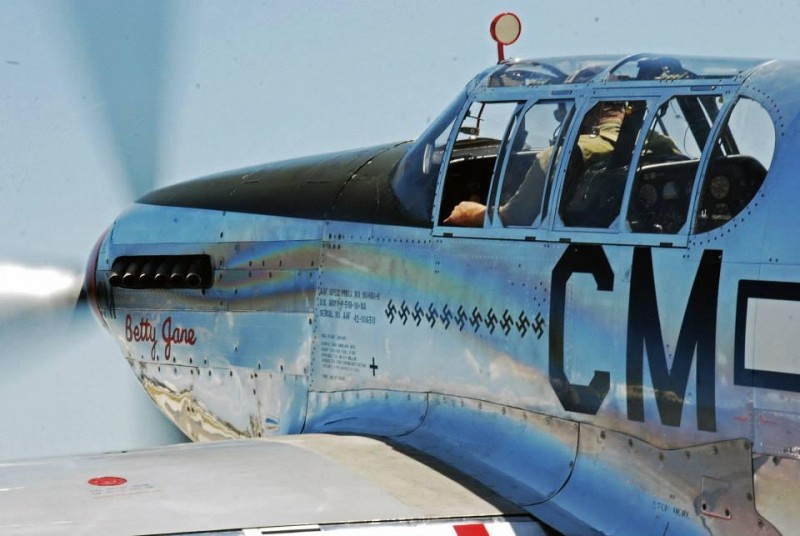
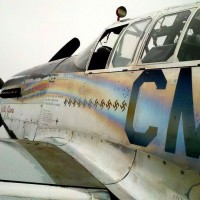

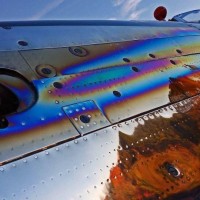
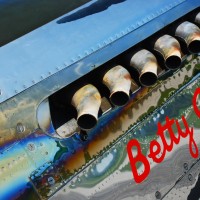
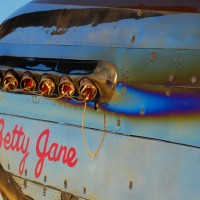

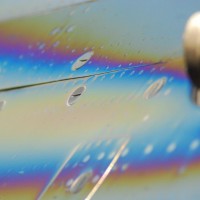
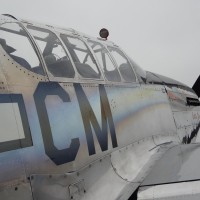

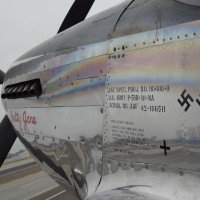
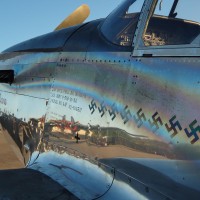
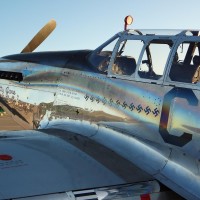

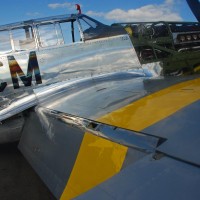
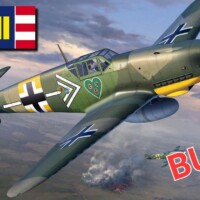
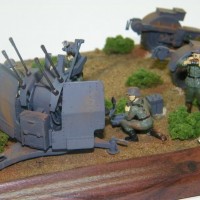
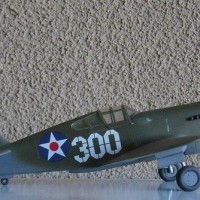

The photos are great, good reference, but I think there suitable for framing with the coloring and such.
Jim, @jimh these are great photos and information. Thanks for sharing with us.
You said that they USED to clean the "heat trail" with high-octane fuel. What do you use, if NOT the fuel? And do you use automotive metal polish and/or wax on the rest of the aircraft?
Thanks for your time. As far as I'm concerned, you MUST be one of the luckiest men alive to have been able to fly a P-51 in this day and age. I could die a happy man if I could fly or even fly IN one! Take care, my friend!
Thanks Jeff, flying Mustangs is certainly an honor...the journey to get there was almost as fun as getting in the seat for the first time. It's hard to describe. I can't speak for all owners but we used everything from Mothers, to Nuvite polishes. We only used gas when it was really stained and that was just to knock off the heavy staining. I can tell you that owners paint their Mustangs silver so they don't have to maintain the finish to the polished level. In the long term a painted surface will last longer, but it sure doesn't look as good. The wings on BJ were painted per the factory and we did wax them with Maguires Quick Detail or Wax Cleaner. Thanks again!
Jim
Jim,
There's just something special about a polished metal finish. The shinier the better ! I'm sure that keeping it looking that way is extremely labor intensive.
My hat goes off to you, those who keep these flying museums in the air for others to see... You are the "missing link" between memories and history.
Both would be forgotten in a generation or two without your work.
Thank you! It's comments like that made life on the road worth all the effort. It really is a special entity. All the groups that tour are keeping this era alive. When I started there were an average of 20-25 veterans in each city that were 'regulars'...by 2016 when I retired we were lucky to see 1 or two. The good news is the family's of veterans and the enthusiasts were still going strong. WWII was quite an era...hopefully to never be repeated but always remembered.
JIm
I remember when the B-17 and B-24 came to VNY in 1996, there were maybe 200 vets showed up. A few less in 1998. About half that in 2001. Half again by 2005...
GREAT pics...thanks. 🙂
These are excellent pictures ! Thanks for sharing these with us.
Helpful, excellent photos, and thoughtful. Top iModeler, Jim.
Great photos. Very interesting, got to love the sexy mustang with that merlin engine. Cheers Jim.
I'm curious, Jim, as to what octane fuel you're burning. If I'm correct, it's probably 100LL (low lead), since as far as I know, no one refines aviation gasoline with anything higher. Most WWII era airplane engines were designed to run on 100+ or higher octane leaded fuel, so I'm pretty sure that has a lot to do with your exhaust coloration. The R-1830s on our Gooney Birds didn't like the 100LL at all and even with the hardened valves and all the carburetor adjustments, they just couldn't make their rated power on that fuel. There's talk about doing away with 100 octane altogether, which would be a disaster for the warbirds as I really don't think any of those engines would run well on 87 octane.
I'm also curious to find out of you have detonation problems at higher rpm's (especially at higher altitude airports) or under load, or if you stay away from that in order to preserve the engines.
Thank you guys for all your great feedback, I really appreciate it. All the big engines run 100LL and not detuned. The Merlin will still pull 61" although I/we use 55" normally for takeoff just to be easy on the engine. Betty Jane was well under combat gross so 61" isn't necessary. It will loop from the cruise setting of 36" but I generally did all vertical acro at 40". I will say there is a huge difference between 55 and 61...it is pretty spectacular. The B-24 runs 1830's with functioning turbos. It honestly won't get off the ground without the turbos, which are pilot and copilot controlled. We have a generic setting for sea-level but the higher elevations required more turbo. We used around 42" for takeoff power, 35" for climb and 30" cruise. The B-17 does not have functioning turbos but it is super light...35" does the job even at higher altitudes. Detonation isn't an issue. There was an announcement around 5-6 years ago about not making 100LL by 2018...BUT there is no suitable alternative ready. There is a company in MN that has been running an R-2800 on an ethanol based fuel that is a direct replacement but I haven't really followed up on that. With the amount of GA airplanes it will be a monumental change. I ran my Cub on car gas for a while and I didn't like it...dried up some gaskets and really made a mess. I replaced what I had to and switched back to 100LL. I hope this helps. Every operator is different and it shows in cylinder changes and engine change cycles. Reverse loading was our biggest nemesis, especially on the B-24...it is all about training and power management. Let me know if I can help more.
Jim
Great Photos Jim - love the P-51B.
What was also really enjoyable was the discussion between you and Jaime! fantastic for all us petrol heads to listen into - you can almost smell the petrol fumes from here ...
Birds of a feather! great discussion, I didn't think it would lead to all this but it is fantastic there is this much interest.
Jim
Great photos Jim. For WW2 P-51s and other Merlin-powered airplane models, I use Tamiya "Smoke", thinned 50-50, building up in repeat passes to the desired level. I've been around them long enough to have seen exhaust from leaded 100 octane, which wasn't so colorful. HTH
Thanks Tom, Merlins are unique engines. When it comes to Mustangs versus Spitfires and Hurricanes the British set up seems to run dirtier. When we first started operating Betty Jane it had a Nixon Merlin installed and it ran really clean but hot...the temp gauge was rarely below 100...until it broke a connecting rod. We then switched to Roush after that and they made some internal cooling mods and changed the valve settings. The temp gauge stayed right around 90 with the radiator door in 'auto'. Unless it was really hot and humid those engines run really cool. The exhaust trail always rainbowed. The Allison burns like a tractor engine for a similar design concept. I'll try the smoke on a 'practice' kit. Thanks for commenting!
Jim
Jim, that's interesting to hear about the turbos on the B-24 still being used. The B-17 I worked on years ago had those deactivated, even though they were installed. The engines on the C-47s I worked on had R-1830-92 engines, some of which had two stage blowers, though the high stage was locked out per an AD due to the extra boost having a tendency to crack cylinders. I suspect a B-24 is a bit less aerodynamic than a Gooney Bird and a whole lot heavier, so having the turbos makes sense.
The R-1830 TC specifies 100/130 or higher fuel. When I was flying in the early to mid 80's, our Gooneys were working girls hauling freight all over the southwest US. We could still get 100/130 fuel in a few places back then, and we did every chance we got because the performance gains over 100LL were noticeable, especially at the hot, higher altitude airports we routinely operated from. Our operating certificate allowed us to fly the C-47 up to 26,900 lbs max takeoff weight, which I'm pretty sure we exceeded a time or three when there was revenue (ie paychecks) to be made. Other than for takeoffs, we pretty much babied the engines as much as possible because overhauls were (and still are) expensive and we'd lose a day of flying for every engine change we had to do.
I don't remember having to clean much exhaust staining off the Gooneys, perhaps because of the way the exhaust was set up or the leaner mixtures we flew in cruise. Most of the dirty I had to deal with was from oil leaks...
The DC-3 is one of the most amazing designs ever conceived. To think that they are still operating and being converted to turbine is simply awesome. You are lucky to have been part of that. The B-24, to put it bluntly, is a pig. The Davis wing design gives it the characteristics of flying a bath tub half full of water. On the step it will cruise at 165mph at lower altitudes...off the step you plow along at 140mph. I've flown it pretty heavy and fairly high (13,000ft) and it really didn't seem to improve. My hat is off to anyone that flew her in combat. The 1830 is probably the smoothest radial engine I've flown but it is really fragile. The gearing in the nosecase is extremely sensitive to reverse loading. If I remember right, the book says if the engine is reverse loaded it is a mandatory engine change. When we had to feather #1 for checkrides we could almost count on a failure within 2 months from the air restart. We were using Precision to do our overhauls and a '0' time 1830 was right around $80k a couple years ago. Cylinders were also getting scarce. The price was about the same for 1820s and cylinders are getting hard to come by as well. I'm not sure if it will be the 100LL or the parts that will shut things down but I tell everyone to enjoy it cause the future is not set in stone.
Jim